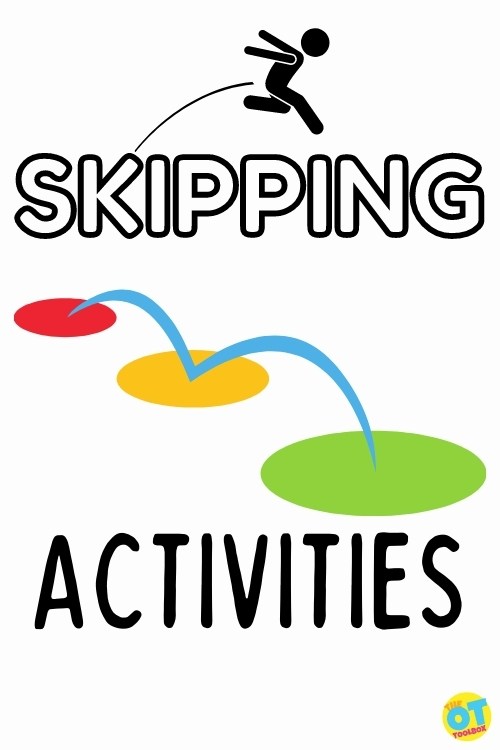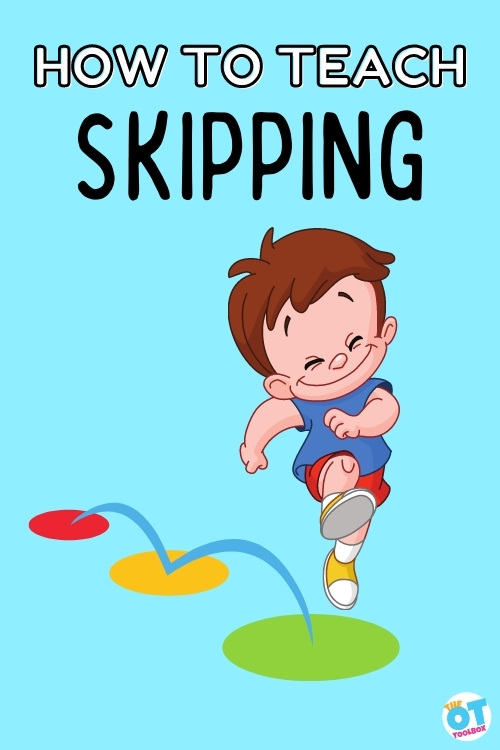Young children often ask to learn to skip. Here, you’ll discover skipping activities for kids, as well as specific strategies to teach children how to skip. Skipping is an important gross motor target. For some children, learning to skip is a real challenge!

Learn to Skip with Skipping Activities
If you have ever spent time in an elementary school, you may have noticed that the youngest members of the school community, specifically kindergarteners, hardly ever walk from place to place… they skip (and hop, jump, twirl, and gallop, too)!
Skipping is a developmental milestone or marker that generally emerges around age 5, with a range of age 4-6 years. For many kids, skipping emerges without intervention, just the way reaching, crawling, or walking develops.
For kids who struggle with gross motor skills and bilateral coordination, direct teaching may be necessary to develop this critical skill. Once the basics are learned, skipping activities are a great way to practice.
learning to skip requires motor planning and sensory integration
Skipping is such a perfect example of motor planning and sensory integration. It requires ideation (having the idea about how to move), planning (sequencing the movement), and execution (carrying out the movement).
For a person to execute the motor plan of skipping, the coordinated effort of sensory systems and the brain is required.
Skipping also provides excellent sensory input. No wonder kindergarteners like to skip from place to place… the vestibular and proprioceptive input they receive is a natural reward for all their hard work in mastering the skill!
what about bilateral coordination?
The ability to coordinate the two sides of the body involved in learning how to skip requires balance, strength, motor planning, and bilateral coordination. Bilateral coordination refers to the ability of the brain and body to process and integrate information from both sides of the brain to respond with movements in a coordinated manner.
Many functional tasks and daily activities, such as feeding, dressing, and writing rely on bilateral coordination.
Being able to coordinate both sides of the body is also a foundation skill for gross motor coordination activities such as walking, running, galloping and skipping.

How to Teach Skipping
When you have a goal for a child to learn to skip, it is important to make sure that you address all of the components of skipping. Teaching kids to skip starts with seeing what skills the individual is able to do. There are skills that are required to skip. Can the child balance on one foot and hop? Does the child have a dominant leg? Can they gallop or perform a different version of skipping? These are all good questions to ask when teaching skipping skills.
First, evaluate and observe the following gross motor skills needed for skipping:
- Balance – check to make sure they can balance on either foot
- Hopping – are they able to hop in place on each foot? Are they able to hop forward on one foot? Have them try to take 5 hops forward on either foot
- Leg dominance – it may be helpful to know if they have a preferred leg for activities like hopping or kicking
- Galloping – are they able to gallop? Can they gallop on either side? This is more of a unilateral skill, which is often easier for kids who demonstrate difficulty with bilateral coordination skills.
If any of the above skills are weak, start with developing balance and hopping. Then progress to galloping, followed by skipping.
Then, use these strategies to teach skipping:
- To teach skipping, start by breaking down the steps for the child. Provide a demonstration and simple verbal cues like “Step, hop, switch”. You may need to provide a visual cue as well, using colored dots or markers on the floor, such as these (Amazon affiliate link) Little Polly Markers.
2. Once the child is able to complete the “step, hop, switch” sequence. This can be a very slow process at first. Some kids will need to think through the motor plan of each step. That’s ok! Use visual and verbal cues to work on the step with one foot, the hop, and the switch to the other foot.
3. Work to improve their fluency and speed of the step, hop switch sequence. Use these steps in an obstacle course or a relay activity to work on speed and gross motor coordination to improve fluent motor skills.
3. As they master the skill of skipping, you can encourage them to incorporate their upper body into the movement as well. Show them how to swing their arms in coordination with the legs. This will become more fluent and integrated with practice.
Working on the coordination and motor planning to master learning to skip involves more than just a hop and a skip. Skipping is a complex task, but once you break it down and address underlying skill areas, it becomes easier.
Skipping Activities
Here are some gross motor coordination games and skipping activities that address bilateral coordination and motor skills:
- Obstacle courses – set up a simple hopping and jumping obstacle course inside or outside. Use pool noodles to jump over with two feet, hop in and out of hula hoops, jump over cardboard bricks, etc. Here is a post about Outdoor Lawn Games with lots of ideas for using backyard toys and equipment to address gross motor coordination skills.
- This Ultra Dash Game (affiliate link) is fun for kids of all ages! You can set up an obstacle course in various ways and then the kids have to race to match the colors from the wand to the colored base. You could incorporate skipping, jumping, and hopping into this game to work on those skills in a new way.
- Use gross motor toys to work on balance, coordination, motor planning, and core strength.
- Use a long jump rope to hop over on one foot.
- Stand like a flamingo. Try freeze dance games with a flamingo theme. When the music stops, players have to hold one leg up like a flamingo!
- Simon says- Incorporate the hop and jump tasks needed in the task of skipping. Use these Simon Says commands in therapy sessions.
- Yoga is a great activity to build body awareness, gross motor skills, and bilateral coordination. Here are several different kids yoga resources:
- Unicorn Yoga Slide Deck freebie from The OT Toolbox
- Yoga Pretzels: 50 Fun Activities for Kids and Grownups Cards (affiliate link)
- Skip ball (affiliate link)- this toy is a fun tool to practice skipping skills
- Chinese Jump Rope (affiliate link) – who remembers this classic toy? Relive your childhood while passing on this great game
- Mini Trampoline (affiliate link)- these are great to work on jumping, hopping, coordination, following directions, all great skills to teach skipping
- Musical Hippity Hop Stick – this rotating stick encourages children to jump over the stick as it rotates by. If the stick touches them, the game is over. Practice this with two feet first, then try hopping over the stick
- Hopscotch! Don’t forget about this one! All you need is some chalk and a sunny day to get outside and practice hopping and jumping. This would be a great activity to set up on the playground for kids to work on skipping skills during recess. Not ready for outside play? Use painter’s tape down the hallway.
spring has almost sprung!
With Spring right around the corner, here are some Spring Gross Motor Activities to use with your students in the upcoming weeks to address gross motor coordination skills.
It’s time to get some “Spring” back in our steps! Bring your kids outside and have some fun working on hopping, jumping, and of course…skipping!

Katherine Cook is an occupational therapist with 20 years experience primarily working in schools with students from preschool through Grade 12. Katherine graduated from Boston University in 2001 and completed her Master’s degree and Certificate of Advanced Graduate Study at Tufts University in 2010. Katherine’s school based experience includes working in integrated preschool programs, supporting students in the inclusion setting, as well as program development and providing consultation to students in substantially separate programs. Katherine has a passion for fostering the play skills of children and supporting their occupations in school.


